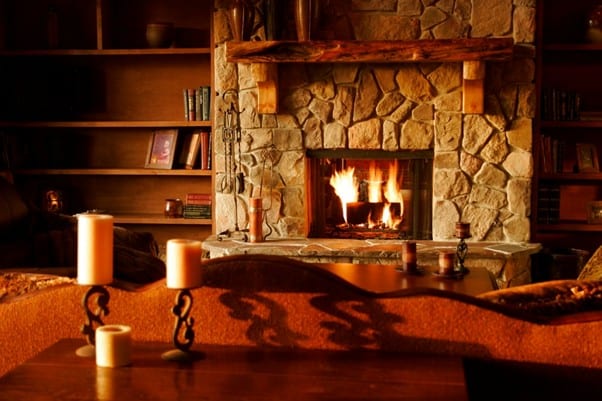A fireplace is a perfect centerpiece for any living room. It also gives a sense of peace, calm and warmth, especially in the cold winter months. But, first, you need to know how to clean a brick fireplace to keep it fresh and soot-free.
Brick fireplaces inevitably accumulate soot and smoky odors regardless of how you maintain them. This is especially true if you have a wood-burning stove that leaves behind ashes. In addition, since some fireplace bricks are porous, cleaning them will require more than a simple soot wipe.
Fortunately for you, this article will cover different methods to help you clean fireplace bricks. We'll include easy-to-access cleaning solutions to make the entire process a breeze. Ready? Let's get into it.
How To Clean A Brick Fireplace
Step 1: Prepare the Brick Fireplace for Cleaning
Before cleaning your fireplace bricks with water and soap, the first step is to clear out the area. Next, you need to remove any leftover ashes, grate and loose soot.
Why is this important?
Try and imagine the mess it would be with wet ash and soot.
So, get a broom and the brush attachment of your vacuum cleaner to loosen up and vacuum the ash and soot. However, it's advisable to use a specific ash vacuum rather than your regular vacuum cleaner if you often clean your fireplace.
Another tip is to ensure the fireplace is cold before clearing out the ash. In addition, you can prepare the surrounding area, say by covering carpets with a waterproof cloth.
This is also the part where you'll need to get your mask, protective eye gear, gloves and a kneeling board if you need one.
Step 2: Wet the Fireplace
Soaking or wetting the fireplace is the second most important step. Again, you'll need a spray bottle or masonry sponge for this step. Since bricks are naturally absorbent, soaking them with water first ensures they don't absorb your cleaning solution.
Remember to protect the surrounding area with waterproof sheeting.
Step 3: Prep Your Cleaning Solution
This step involves preparing your cleaning solution. Again, there are several options to choose from depending on your preference for natural or manufactured cleaning products. Additionally, the magnitude of staining and the age of the bricks will also influence your decision.
Below are a few fireplace bricks' cleaning solutions to choose from:
i). How to Clean A Brick Fireplace With Vinegar
Vinegar is amazing for cleaning fireplace bricks. However, you want to use it on relatively newer bricks. In addition, keep in mind that using vinegar on old(more than 20 years old) bricks could damage them.
Vinegar's acidity property makes it great for cleaning soot stains and odor from the fireplace. Follow the steps below to prepare your vinegar solution.
Steps:
- Mix equal parts vinegar and warm water in a spray bottle
- You can add a little dishwashing liquid
Unfortunately, although vinegar is a gentle cleaner, you will need to scrub a lot to get all the dirt and stains out. You may also need to use a bit of baking powder paste to reduce the effects of vinegar on the fireplace.
ii). How to Clean A Brick Fireplace With Dishwashing Detergent
Another mild alternative to clean your fireplace brick is using a dishwashing detergent. Since it's super mild, you can also use it on old bricks without worrying about damage.
You also want to ensure you use a clear detergent with grease-cutting capabilities for this type of cleaning.
Steps:
- Mix 1/4 cup dishwashing liquid to 4 cups of water
- Dip a scrub brush into the solution
- Sprinkle salt on the wet scrub brush
Using salt and dishwashing detergent to clean brick fireplaces helps loosen up the soot and dirt, making the process easier.
iii). How to Clean A Brick Fireplace With Baking Soda
Making a baking soda and dishwashing detergent paste will guarantee you clean bricks. However, be prepared for a lot of scrubbing in a circular motion to loosen up and clean the dirt and soot.
Steps:
- Add a few tablespoons of dishwashing detergent to half a cup of baking soda
- Mix to form a paste
- Apply the paste to the bricks
- Leave it for about 10 minutes
- Scrub
iv). How to Clean A Brick Fireplace With Cream of Tartar
Yes, you read that right. Surprisingly, you can use cream of tartar to clean the pesky soot stains in fireplaces and chimneys. On the downside, however, you will need a lot of this cream for cleaning fireplace brick.
Steps:
- Use water and cream of tartar to form a thin paste
- Apply on the fireplace bricks
- Use a scrub brush to clean the bricks
- Rinse with warm water
v). How to Clean A Brick Fireplace With Strong Cleaning Solutions
Stronger detergents might be necessary if stains persist after using the cleansers above. However, you want to be careful with these strong detergents as they may damage your older bricks.
Additionally, since you'll be working with strong and possibly potent detergents, it's advisable to wear gloves and work in a ventilated area.
Examples of strong cleaning solutions for stubborn stains include:
- 1/2 cup of ammonia, 1/4 cup of dish soap and 4 cups of water. You can add finely-grounded pumice powder in place of salt to loosen stubborn soot stains
- 1/8 cup TSP(trisodium phosphate) and 1L of hot water
Step 4: Apply the Cleaning Solution and Scrub the Fireplace
So, you have picked your cleanser of choice and you're ready to get to work. The next step is to apply the solution to the fireplace bricks.
First, depending on the texture of your solution, you can use a spray bottle to spritz on the bricks or a sponge if your solution is in a bucket. In addition, you can use a paintbrush to apply the cleanser.
Another tip is to work from top to bottom. This ensures that the dirty water does not drip down and leaves streak marks on clean areas. It's also recommended to work on a small area at a time.
This helps ensure that the cleanser doesn't dry out as you're working on a different area. Circular motions with a scrub brush are a must to clean effectively.
Finally, don't shy from lightly adding more cleanser and leaving it to sit a bit before scrubbing when you encounter stubborn stains.
Step 5: Rinse
You want to rinse an area once you're done scrubbing before moving to a different area. This ensures that the cleanser doesn't stay for long on the brick. In addition, you're sure a specific area is clean before moving to the next.
Another tip is always to use clean water when rinsing. Immediately change the water if it gets dirty.
Step 6: Use A Spot Cleaning Method to Remove Remaining Stains
Spot cleaning helps deal with the toughest stains, especially when the gentler cleansers like baking soda have failed. Fortunately, you can try out some of the stronger cleaning solutions mentioned above on areas with tough stains.
Step 7: Repeat Until the Brick Fireplace is Clean
The ultimate goal is to have fresh and clean bricks. So, repeat these methods until the fireplace bricks are as clean as you'd want them to be.
How Often Should You Clean Your Brick Fireplace?
Regularly cleaning your brick fireplace ensures that not much soot and dirt accumulate. While the National Fire Protection Association recommends having your fireplace inspected annually to ensure it's up to standards.
Ideally, it's necessary to give your fireplace a weekly cleanup and maintenance. By removing loose ash, soot and debris regularly, you are preventing excess soot from latching on the fireplace's walls.
Regularly sweeping the hearth is also key to minimizing ashes spreading around the house. Similarly, cleaning out soot frequently prevents discoloration since soot is notorious for flying out around your house.
It's recommended to deep clean your fireplace bricks at least every 6 months. However, you could schedule this for times when you're done using it, such as after the winter months.
The main reason for this is to prevent creosote build-up, which is highly flammable and causes uncontrolled fire.
Additional Tips On Cleaning Brick Fireplaces
- Spot clean your brick fireplace whenever you see soot stains.
- Make cleaning your brick fireplace a regular activity. You can remove ashes and soot weekly and have a deep clean every 6 months.
- Sprinkle wet coffee grounds on the fireplace before sweeping. This helps to prevent the ashes from flying around in your house.
- Avoid using abrasive cleaning products. This is because they could damage the bricks and the fireplace in general.
- Don't use products with flammable chemicals. This helps prevent uncontrolled burning or excessive burning when you light a fire.
- Start by cleaning a small area to test out your DIY products first. You can check how the bricks will react to the cleaning paste in terms of discoloration and other harsh reactions by spot cleaning.
- Use a folded towel to place on your knees when cleaning the fireplace. This will give your knees a cushion. You can also use a kneeling board for this.
- Place a waterproof drop cloth to prevent water from wetting things like pillows and carpets near the fireplace.
Frequently Asked Questions
1. What is the best way to clean a brick fireplace?
The best way to clean a brick fireplace is to use mild and gentle products. This helps to protect old bricks, especially those older than 20 years.
Mild cleaning products you can use include baking soda, vinegar and dish detergent. Another tip is to clean in circular motions using a scrub brush. This will help loosen the dirt and make cleaning a breeze.
You also want to clean one spot before moving on to the next. In addition, clean from top to bottom to prevent streaks from forming on cleaned surfaces.
2. Does vinegar harm brick?
No. Vinegar is a mild and gentle cleanser and will not damage newer bricks. However, you want to be careful when using it on old bricks as it could be damaging. In addition, vinegar can cause discoloration to bricks, so you need to rinse it with baking soda.
3. How do you bring an old brick fireplace back to life?
Thoroughly cleaning your brick fireplace with vinegar, baking soda, or dishwashing detergent will help bring it back to life. You can also use stronger products like ammonia to deal with pesky stains.
Regular cleaning and maintenance will help bring your fireplace back to life once the accumulated soot and dirt are cleaned out.
Image source:alldryus.com














